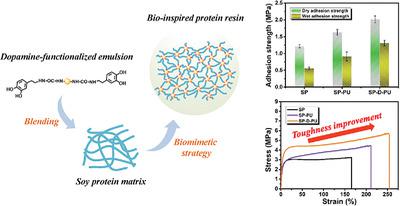当前位置:
X-MOL 学术
›
Macromol. Mater. Eng.
›
论文详情
Our official English website, www.x-mol.net, welcomes your
feedback! (Note: you will need to create a separate account there.)
Designing Biomimetic Microphase‐Separated Motifs to Construct Mechanically Robust Plant Protein Resin with Improved Water‐Resistant Performance
Macromolecular Materials and Engineering ( IF 4.2 ) Pub Date : 2020-01-03 , DOI: 10.1002/mame.201900462 Shujun Zhao 1, 2 , Zhong Wang 1, 2 , Huiwen Pang 1, 2 , Zhi Li 1, 2 , Wei Zhang 1, 2 , Shifeng Zhang 1, 2 , Jianzhang Li 1, 2 , Li Li 1, 2
Macromolecular Materials and Engineering ( IF 4.2 ) Pub Date : 2020-01-03 , DOI: 10.1002/mame.201900462 Shujun Zhao 1, 2 , Zhong Wang 1, 2 , Huiwen Pang 1, 2 , Zhi Li 1, 2 , Wei Zhang 1, 2 , Shifeng Zhang 1, 2 , Jianzhang Li 1, 2 , Li Li 1, 2
Affiliation

|
Plant protein, as a sustainable alternative to petroleum‐derived resin, has exhibited notable potential for engineering wood products without formaldehyde emission, while the poor mechanical and water‐resistant performances limit its practical applications. Inspired by mussel chemistry and structure, a dopamine‐functionalized polyurethane (D‐PU) elastomer is synthesized in this work acting as a bio‐inspired crosslinking unit to improve the properties of soy protein (SP) resin. It is found that the catechol groups of the incorporated D‐PU not only triggers polyurethane to interact with SP matrix giving rise to a stable crosslinking network with excellent load‐bearing capacity, but also serves as a water‐resistant barrier to reduce the water erosion effect on resin. Moreover, a desired microphase‐separated morphology is observed within the continuous protein phase after introducing D‐PU. The microphase‐separated structure simultaneously strengthens and toughens SP adhesive layer, thus achieving high‐efficiency stress transfer and energy dissipation as well as accelerating SP to further permeate into the substrate forming more mechanical adhesion nails. As a result, the modified SP‐D‐PU resin presents an impressive improvement in dry and wet adhesion strength up to 70.5% and 133.9% compared to the pristine SP resin, respectively. The proposed biomimetic design may offer a workable strategy for preparing of high‐performance bio‐based composites.
中文翻译:

设计仿生微相分离的模体,以构建具有增强的耐水性能的机械坚固的植物蛋白树脂
植物蛋白作为石油衍生树脂的可持续替代品,对于不含甲醛释放量的工程木制品具有显着的潜力,而差的机械和防水性能限制了其实际应用。受贻贝化学和结构的启发,在这项工作中合成了多巴胺官能化的聚氨酯(D-PU)弹性体,作为生物启发的交联单元,可改善大豆蛋白(SP)树脂的性能。发现掺入的D-PU的邻苯二酚基不仅触发聚氨酯与SP基质相互作用,从而形成具有出色承载能力的稳定交联网络,而且还充当了减少水蚀的防水屏障对树脂的影响。此外,引入D-PU后,在连续的蛋白质相中观察到所需的微相分离形态。微相分离的结构同时增强和增粘了SP胶粘剂层,从而实现了高效的应力传递和能量消散,并加速了SP进一步渗透到基材中,形成了更多的机械粘合钉。结果,与原始SP树脂相比,改性SP‐D‐PU树脂的干,湿粘合强度分别显着提高了70.5%和133.9%。拟议的仿生设计可能为制备高性能生物基复合材料提供可行的策略。从而实现了高效的应力传递和能量耗散,并加快了SP的渗透速度,使其进一步渗入基材,形成了更多的机械粘合钉。结果,与原始SP树脂相比,改性SP‐D‐PU树脂的干,湿粘合强度分别显着提高了70.5%和133.9%。拟议的仿生设计可能为制备高性能生物基复合材料提供可行的策略。从而实现了高效的应力传递和能量耗散,并加快了SP的渗透速度,使其进一步渗入基材,形成了更多的机械粘合钉。结果,与原始SP树脂相比,改性SP‐D‐PU树脂的干,湿粘合强度分别显着提高了70.5%和133.9%。拟议的仿生设计可能为制备高性能生物基复合材料提供可行的策略。
更新日期:2020-02-14
中文翻译:

设计仿生微相分离的模体,以构建具有增强的耐水性能的机械坚固的植物蛋白树脂
植物蛋白作为石油衍生树脂的可持续替代品,对于不含甲醛释放量的工程木制品具有显着的潜力,而差的机械和防水性能限制了其实际应用。受贻贝化学和结构的启发,在这项工作中合成了多巴胺官能化的聚氨酯(D-PU)弹性体,作为生物启发的交联单元,可改善大豆蛋白(SP)树脂的性能。发现掺入的D-PU的邻苯二酚基不仅触发聚氨酯与SP基质相互作用,从而形成具有出色承载能力的稳定交联网络,而且还充当了减少水蚀的防水屏障对树脂的影响。此外,引入D-PU后,在连续的蛋白质相中观察到所需的微相分离形态。微相分离的结构同时增强和增粘了SP胶粘剂层,从而实现了高效的应力传递和能量消散,并加速了SP进一步渗透到基材中,形成了更多的机械粘合钉。结果,与原始SP树脂相比,改性SP‐D‐PU树脂的干,湿粘合强度分别显着提高了70.5%和133.9%。拟议的仿生设计可能为制备高性能生物基复合材料提供可行的策略。从而实现了高效的应力传递和能量耗散,并加快了SP的渗透速度,使其进一步渗入基材,形成了更多的机械粘合钉。结果,与原始SP树脂相比,改性SP‐D‐PU树脂的干,湿粘合强度分别显着提高了70.5%和133.9%。拟议的仿生设计可能为制备高性能生物基复合材料提供可行的策略。从而实现了高效的应力传递和能量耗散,并加快了SP的渗透速度,使其进一步渗入基材,形成了更多的机械粘合钉。结果,与原始SP树脂相比,改性SP‐D‐PU树脂的干,湿粘合强度分别显着提高了70.5%和133.9%。拟议的仿生设计可能为制备高性能生物基复合材料提供可行的策略。











































 京公网安备 11010802027423号
京公网安备 11010802027423号